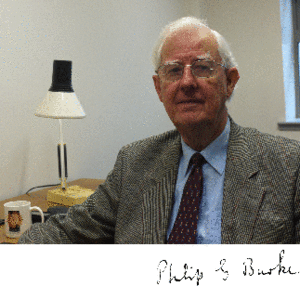Philip George Burke facts for kids
Philip George Burke (born October 18, 1932 – died June 4, 2019) was a smart British scientist. He was a special kind of physicist. This means he studied how the world works at a very basic level. He focused on two areas:
- Theoretical physics: This is like being a detective who solves puzzles using math and ideas, without needing a lab.
- Computational physics: This involves using powerful computers to solve those puzzles and test ideas.
Dr. Burke was famous for creating something called the R-matrix method. This is a special way to understand what happens when tiny particles called electrons bump into atoms and molecules. It helped scientists learn more about how matter behaves.
Contents
Philip Burke's Life and Work
Philip George Burke was born in London, England. He went to college at the University College of the South West and University College London. These are both well-known universities.
Early Career
After finishing his studies, Dr. Burke worked at the National Physical Laboratory in Teddington. This is a place where scientists do important research. For a short time, from 1959 to 1960, he also worked in the United States. He was at the Lawrence Berkeley Radiation Laboratory.
Work at Queen's University Belfast
Most of Dr. Burke's research career was spent at Queen's University Belfast in Northern Ireland. He was an important member of a group there. This group was called the Centre for Theoretical Atomic, Molecular and Optical Physics. They studied how atoms, molecules, and light interact.
Awards and Recognition
Dr. Burke's amazing work was recognized by many. In 1978, he was chosen to be a Fellow of the Royal Society. This is a very high honor for scientists in the United Kingdom. Later, in 1993, he received an award called a CBE. This award is given by the British monarch for great achievements.


